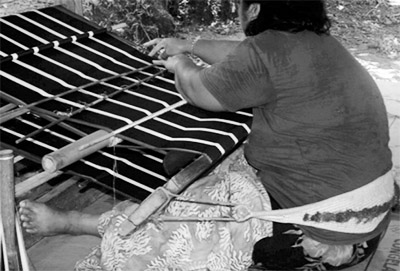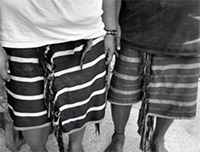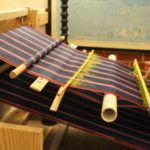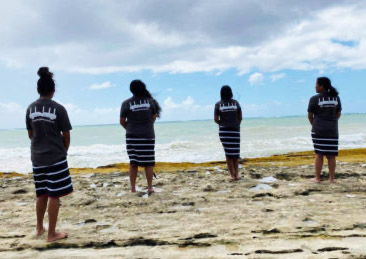Loom is a solution for saving traditional Pacific island weaving from extinction
By Joyce McClure, The Pacific Island Times

Traditional backstrap loom made and used by Remathau, or Outer Islanders, of Yap. The strap is made of coconut fiber and lasts for many years. The loom is made of local mahogany wood and bamboo. Photo by Joyce McClure
When the young women of Yap’s remote outer islands leave home to seek a college education, better work opportunities or medical care on the U.S. mainland, the risk of leaving their cultural traditions behind is very real.
The art of traditional weaving is among the most important.
Weaving has been passed down from mother to daughter for centuries on the small islands and atolls of Yap, one of four island states in the Federated States of Micronesia, originally known as the Caroline Islands. Scattered across 100,000 square miles of open water in the western Pacific Ocean, Yap is made up of four contiguous main islands and 134 atolls and islands of which 19 are inhabited.

Women’s handwoven lavalavas worn by Remathau,
One commonality among the outer islanders is the oblong length of handwoven, fringed fabric called a lavalava that the women wear as a wrap-around skirt when they reach maturity.
Woven on a handmade backstrap loom out of indigenous wood and bamboo, the young girls begin learning to make the striped cloth by watching their mothers, aunts, sisters and cousins at work. Originally woven of dried hibiscus leaves, today, spools of imported commercial thread are more commonly used.
But the art of weaving is in danger of being lost forever due to the loosened ties between the old and new generations as the younger women leave their island home.
However, that isn’t the only reason the art is being lost to time.
The backstrap looms, many of them heirlooms, are left behind when the young women leave their home islands due to its weight and size.
Once in the United States, the young women often live near older women from the islands who have weaving expertise, but also lack looms.

Neil Mellen
“It’s at this point that the link in the transmission of weaving skills is fatally severed,” said Neil Mellen, founder of Habele, a South Carolina-based nonprofit established by former Peace Corps volunteers who served in Micronesia [2002–04].
Working with the “Remathau,” or Outer Islanders, of Yap, Habele is finding solutions to this loss of ancient skills and knowledge.
To help “sustain the tradition among migrants in the mainland U.S.,” Habele created and launched the online resource, WeavingConnections.org, in February 2021. Designed to provide a do-it-yourself guide, it focuses on serving Outer Island Yapese in their native language, who live within the mainland U.S.
The site provides context about the lavalava and the cultural tradition in which it is situated; but most importantly, it provides well-researched details about the parts of the loom and simple do-it-yourself instructions showing how to build one from materials available in the U.S.
While weaving is a daily necessity for the women in these ancient island cultures, making the loom is a man’s responsibility. Men learn woodcarving from boyhood in order to make the outrigger canoes used to sail from island to island. This knowledge extends to making the looms and other wooden items from native materials.
A master weaver from the island of Fais, Regina Raigetal and her husband, Larry, a master carver and navigator from the atoll of Lamotrek, traveled to Habele’s office in Columbia, South Carolina, to serve as project leads. In partnership with weavers, craftsmen, women’s and community-based organizations in the Pacific region, and with U.S.-based anthropologists, “simple, actionable, accurate guides were created.”
Research resulted in a thorough analysis “of the limited number of references to the design and use of the region’s backstrap looms” in academic studies, books, and online museum and archive collections. Most contained brief mentions of the social and cultural significance of the lavalavas within longer articles about the arts and crafts of the Pacific islands; but only a handful mentioned the loom in any depth, and none addressed the materials and tools needed to make them, or their use in the weaving process.
Photographs, drawings, and videos were obtained from Yapese weavers and those who have moved to other FSM islands, Guam and Hawaii, and Peace Corps volunteers who once served in Yap.
Collectors and anthropologists were also contacted for information to help identify place-based differences between the construction of the loom frames and warping boards used on the islands of Ulithi, Woleai and Satawal. Most notable were the variations in the warping board pegs that dictate the design patterns.
Finally, a scale model and a full-size model of a warping board and a framed loom were constructed.
Regina Raigetal was joined by a former Peace Corps volunteer experienced in both Carolinian and Western-style weaving, to begin testing the prototypes.
 Adjustments took into account the weavers’ preferences, including ease of transportation and storage since many of the weavers needed to have their boards and frames made by Habele and its volunteers, or off-site relatives, and then shipped to them. They often experience cramped living spaces and periodic relocations, as well, making compactness and transportability essential.
Adjustments took into account the weavers’ preferences, including ease of transportation and storage since many of the weavers needed to have their boards and frames made by Habele and its volunteers, or off-site relatives, and then shipped to them. They often experience cramped living spaces and periodic relocations, as well, making compactness and transportability essential.
The 15 tools used in the weaving process were also acquired, crafted, or assembled to pinpoint the practical purpose of each item and the material it was made from. The objective was to determine “how, and if, substitutions or alterations could be made that would not impair, and possibly improve,” the process.
Recommendations were provided for the purchase, fabrication, or substitution for all but one of the tools – the beater or weaving sword, called the “hapop” in both Ulithian and Woleaian.
Traditionally made from hardwoods that provide the weight needed to create the warp-faced fabric, while maintaining a sufficiently sharp edge, ironwood, known to the islanders as “weighu,” is the common choice.
While the sword can be made of store-bought hardwoods like oak on the mainland, they lack the weight and density the weavers need. The only woods commonly found in North America that approach the hardness of ironwood are black ironwood, desert ironwood and mountain mahogany, but these are either cost- or shape-prohibitive. Woods from the Caribbean are also being tested as possible alternatives.
“That being the case,” Mellen said, “we are not able to provide much practical guidance to weavers in the U.S. who need a sword.”
Directions on WeavingConnections.org suggest that those who lack the tool should “look to friends and relatives back home to send them a hapop or contact Habele for help.” Making a hapop from live oak is also suggested.
Another challenge arose when requests were posted on the Facebook page from women saying they “would have a difficult time finding a male relative” to build the items, even with detailed instructions. Single women or women living in groups with children, but without adult men in the household, noted the challenge of building one.
“In response to those weavers who are unable to build one, or have one built, we are constructing warping boards, loom frames, and weaving tools based on the designs on WeavingConnections.org,” Mellen said.
The organization is also continuing to update the design guides “to reflect feedback received, lessons learned, and improvements, and examine and experiment with possible solutions to the challenges of procuring, crafting, or developing a sufficient substitute for the hapop,” he added.
Planning is now focused on supporting mentors in the U.S. who can teach the traditional weaving skills to younger Micronesian migrants and their daughters.
Weaving Connections, a project of Habele to sustain and preserve Micronesian backstrap weaving traditions among Island populations who’ve migrated to the United States mainland.
Established by former American Peace Corps who served in Micronesia, Habele is a 501(c)(3) nonprofit promoting educational access and accomplishment among Micronesian communities.
“Weaving Connections” an initiative of Habele established in 2020 to support Remathau women in the mainland United States. “Weaving Connections” helps in sustaining and continuing their distinctive weaving traditions that keep and maintain cultural identities and can provide means for economic support.
Initial support for this project came from the U.S. Department of the Interior’s Office of Insular Affairs.

•
See Neil speaking about Habele on YouTube.
Donate to Habele .
All photos by Joyce McClure
No comments yet.
Add your comment